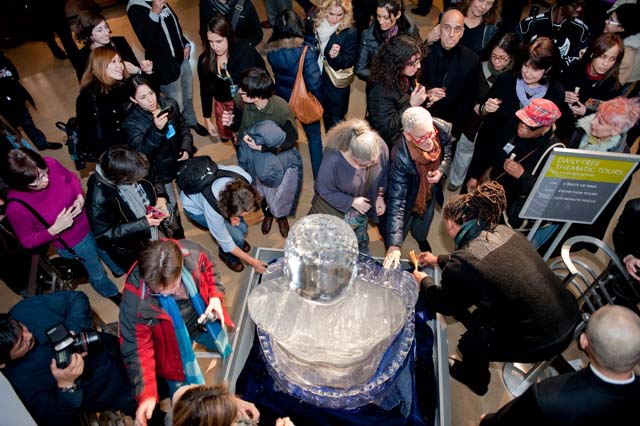
ACAW – The Arts of Asia Come to New York
A five foot, 1300 pound Buddha sculpted out of ice by the Korean contemporary artist Atta Kim sits tranquilly in the foyer of the Rubin Museum of Art, slowly, slowly melting away. The lit up museum is open throughout the night, as viewers come, fascinated by the impermanence of things. Throughout the weekend, the image slowly vanishes, and viewers are invited to touch and take away the melting ice home in tiny containers. Kim wanted the water from his monumental ice sculpture to nurture a growing seedling or plant, to continue the cycle of renewal…
Yes, in the month of March, Asian art came to New York in many surprising shapes and forms – paintings, sculptures, installation art, performance art and videos- heralding the annual Asian Contemporary Arts Week, a vigorous celebration of this diverse continent – with art and artists, music, dance and food.
The city of New York became a little Asia as art lovers moved from gallery to gallery, museum to museum in pursuit of that which was familiar, and that which they had never seen. So while there were noted, famous names, there were also new, emerging artists, unknown works of art and bold new ideas.
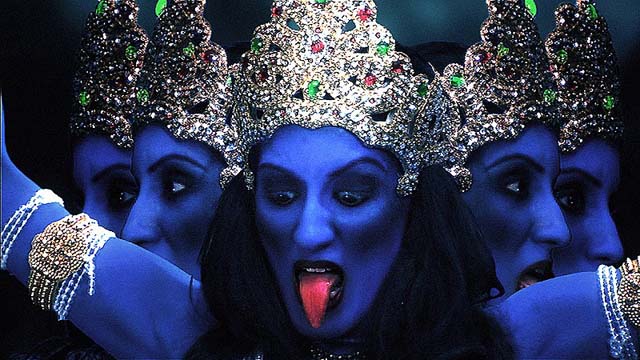
This feast of Asian art was initiated in 2002 by Vishaka Desai, who was then the museum director and is now the president of Asia Society. It was a collaboration of several organizations, with funding from the Asian Cultural Council, connecting leading New York City galleries and museums in a citywide event of public programs such as exhibitions, receptions, lectures and performances.
The week – actually eleven days – focuses on a kaleidoscope of artworks produced by Asian contemporary artists working in their home countries and abroad. The best part is the chance to see the works up close and meet the artists face to face, and listen to them talk about the creative process.
Where else would you be able to jump from India to Japan to Korea to Iran and China – all in the span of a few hours? Art lovers ate art for breakfast, lunch and dinner as they sped from gallery to museum to auction house. At Sotheby’s they could catch a dialogue between Pakistani artist Rashid Rana and Pooja Sood; the director of ‘Khoj’ or at Bose Pacia view Conundrum, an exhibition featuring noted contemporary artists from India, including Aditya Pande, Anita Dube, Arunkumar H.G., Raqs Media Collective, Mithu Sen, & Suhasini Kejriwal.
An entire day was devoted to the art district of Chelsea with numerous galleries participating in the Asian fest. At Chambers Fine Art, you saw Layers, the dramatic series of paintings by Xianoze Xie, depicting stacks of Chinese books and newspapers, and what they really depicted; at Jack Shainman Gallery, Delhi artist Vibha Galhotra showed her wall hangings made of ghungroos, hinting at the new generation’s challenging of tradition; at Priska C. Jushka Fine Art, video artist Almagul Menlibayeva showed the people of the Aral Sea region.
Also in Chelsea, you stopped by Sundaram Tagore’s Gallery where you had a virtual Pan Asian show with artists whose very names showed their diversity – Hiroshi Senju, Anil Revri, Sohan Qadri, Kim Joon, Nathan Slate Joseph, Bob Yasuda, Nhat Tran, Amina Ahmed, and Taylor Kuffner. In the course of a few hours you could span Asia in Chelsea.
Leeza Ahmady, the director of ACAW since 2004, has seen many changes in the scope of this festival. As she points out, there is a tremendous sense of confusion and fragmentation in reference to how Asia is presented not only in the arts, but also in spaces of politics, and policy making.
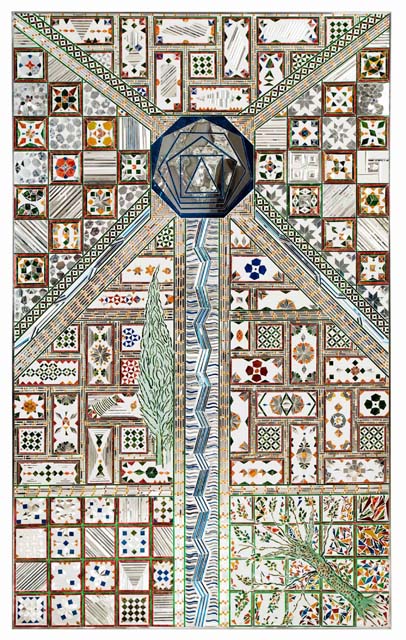
“While I find the term ‘Asian art’ problematic, I believe it is worth tackling exactly because of that aspect,” she says. “Beyond aesthetics, there is a lot to detangle around issues of art in relationship to regions, exhibition spaces, the art market and art education, as well as the division and interconnections between local and international arenas, on how artists deal with issues of cultural specificity.”
Interestingly, ACAW includes artists from the Middle East, Central Asia, and South East Asia, and also non-Asian focused galleries and museums to broaden the program, reflecting the shifting reality of many NYC museum and galleries who were beginning to represent one or two artists in their rosters. The consortium members since then have expanded to include Museum of Modern Art, and the Guggenheim Museum, and this as Ahmadi points out, is a reflection of changes and fluxes that occur in the scene itself.
The Asian art trail was spread all over Manhattan: At the Guggenheim Museum there was a screening of Taiwanese director Hou Hsia-Hsien on the artist Liu Xiodong – and right after that Alice Monroe, a senior curator of art at the Guggenheim, had a one on one dialogue with the artist himself. So viewers had many added pleasures to seeing the art.
You also got to see the unexpected. In recent years Japanese contemporary art has been about manga (animation) and cute Hello Kitty’s inspired art. At the Japan Society viewers got to see the work of 16 artists, who curator David Elliot said, “meld traditional styles with challenging visions of Japan’s troubled present and uncertain future.” (See sidebar)
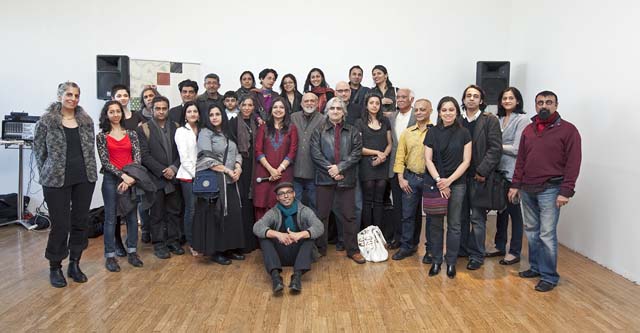
AT ACAW, Asia by Taxi, Bus & Subway…
The Week encompassed all parts of Asia with intriguing exhibitions from China Institute to Gallery Korea to Taipei Cultural Center. The trip to Asia was by taxi and bus and subway, going from the upper reaches of Manhattan right down to Chinatown.
Ask Melissa Chiu, Director of the Museum at Asia Society, as to which country is producing the most vibrant art, and she says, “I think it depends how you measure that: for sheer volume you could say India and China take the lead and have very well developed markets for their work. On the other hand you could say artists in countries like Japan and Korea have not had the same level of attention but the work is just as significant in being able to portray what’s going on today in those countries.”
Indeed, Asia Society spotlighted renowned Iranian artist Monir Farmanfarmaian in the signature event of ACAW, talking about her work with Chiu. The artist who received the 1958 Venice Biennale’s Gold Medal, lives in Iran and discussed her life and art.
“It is like I am standing in the center of a circle and seeing what is going on all around in respect to the larger picture,” says Ahmadi. “It allows for continuous hands-on learning. There is a unique collective spirit to the project. An amazing example of how profit and nonprofit institutions can come together to further a larger mission, which in the case of ACAW, is to educate.”
As for the young artists of the South Asian Diaspora, art is alive and well – and kicking as seen at the at the Queens Museum of Art. When the Indo-American Arts Council put out a call for submissions, they received over a hundred, and finally 43 were selected. These young artists each brought their own perspectives. According to Vijay Kumar, artist and curator of the show, one of the outstanding pieces was ‘Lahore of Today’ by Fasth U Ashan, done in traditional miniature style but in a contemporary fashion. Tanu Jindal, the director of the exhibition, cited the Srinivas Krishna video installation, ‘When the Gods came down to earth’ – where mythology and hi-tech mix outrageously.
At the China Institute, in a formal setting in a townhouse in a richly paneled room was a fascinating discussion with Chinese artist Xianoze Xie, and art lovers had the pleasure of shaking hands with the noted artist, of having a photo taken.
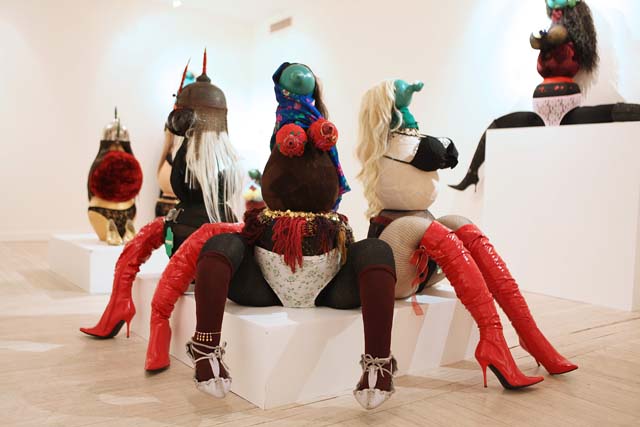
Shirin Fakim – The Tell Tale Tart
And then there were some artists who were more present in their absence, in the powerful stories their work told. One such artist is Shirin Fakim, who could not venture out of Iran, but whose exhibition The Tell Tale Tart was shown at LTMH Gallery on Madison Avenue. To view this is to come away disturbed, melancholy.
Imagine a room full of women, prostitutes, lowest of the low. They are faceless – without an identity, without a future. They are created out of found objects, the flotsam and jetsam of society. Their heads are fashioned out of jars, their breasts are jars shaped like voluptuous melons– after all, aren’t women objects? They lack hands, and some even their lower limbs, they have no standing in society. Clad in flashy underwear and gold heels, they are what they wear, sexual objects in an uncaring society.
And yet to stand in that small room with these life-sized, lifeless women was to feel their presence and their pain. It seemed almost a community. As Media Farzin, a young Iranian artist, explained it, “Shirin is part of a group of artists who are very attentive to what’s happening on the streets, they are very attentive to what’s happening in society.”
This work would never be shown in Iran, and suddenly the impact of these 11 days became quite clear to me. As Farzin mused, “Here artists get a chance to get a visibility with a certain kind of audience. If there wasn’t a week dedicated to this kind of work, they’d have to be fighting for opportunity with everything else in New York, which is such a dense city with so much going on. So this is for people who really care about art, to give the artists a platform for their work.”
© Lavina Melwani
(This article first appeared in Housecalls )
Inside Japan At ACAW
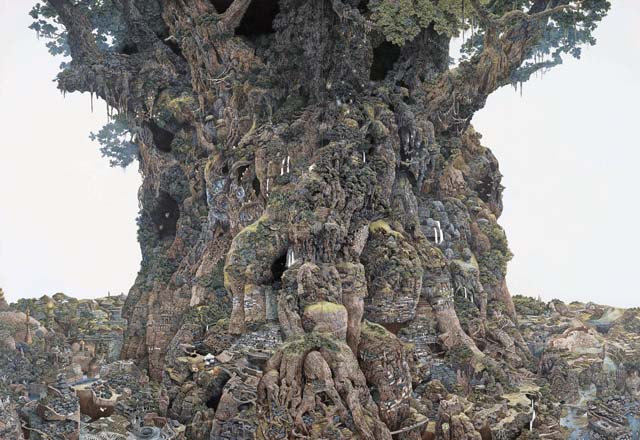
History of Rise and Fall, 2006
Pen and acrylic ink on paper, mounted on board
78 ¾ × 78 ¾ in.
Courtesy Mizuma Art Gallery, Takahashi Collection
Photo: Kei Miyajima
Copyright © IKEDA Manabu
Manabu Ikeda works in ink and acrylic paint applied by pen onto paper, creating large,
intricate works teeming with the details of lives that are socially and metaphysically
linked. In History of Rise and Fall, success and failure, nature, history, and human presence coexist within the confines of an ancient castle supported by branches and roots that simultaneously reflect the four seasons, while the missile-like streaks in the sky at top left represent the ever present threat of nuclear obliteration, in this case from North Korea.
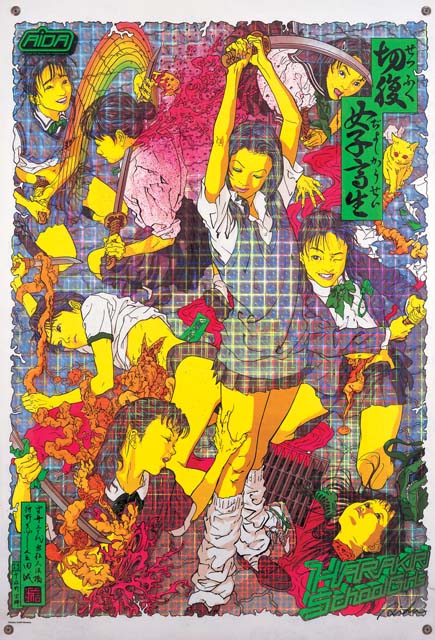
Harakiri School Girls, 2002
Print on transparency film, holographic film, acrylic
46 ¾ × 33 3/8 in.
Courtesy Mizuma Art Gallery. Watai Collection
Photo: Kei Miyajima. Copyright © AIDA Makoto
Makoto Aida’s work combines social critique with nihilistic humor, tempered by
the artist’s respect for the styles he lampoons. Harakiri School Girls combines the
fetishistic fashions and nubile bodies of fantasy schoolgirls with the time-honored
samurai practice of ritual suicide. Its drawing style alludes to the work of Tsukioka
Yoshitoshi (1839–1892), an artist often dismissed as “decadent” because of his violent
subject matter, madness, and Western influences. In the battle for urban cultural
life, Aida’s principal enemy is the gray-suited “salaryman,” whose conformism and
lack of individual spirit he abhors. The enormous Ash Color Mountains (2009–10)
shows the corpses of hundreds of salarymen, each depicted in loving detail, on vast
gray tumuli.
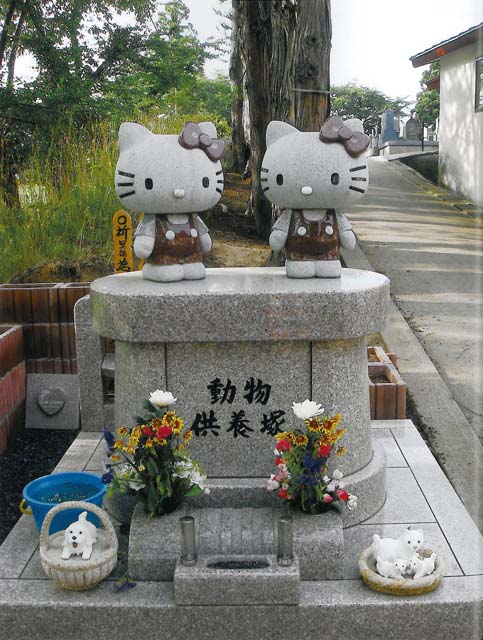
Untitled, 2008 by Yoshimoto Nara
C-print photograph
10 ½ × 7 7/8 in.
Courtesy Tomio Koyama Gallery
Copyright © Yoshitomo Nara
Well known to New York audiences thanks to his recent solo show at Asia Society,
Yoshitomo Nara, is famous in both Japan and the West for his engagement with
popular culture. Cartoonlike paintings of children, or installations of toys, form the
basis of his work, yet they undermine the kawaii (“cute”) aesthetic through their
subversive, at times malicious, self-awareness. In 2008 he published this photograph
of a beautifully maintained tomb for pets, crowned with two large, symmetrical
Hello Kitty polychrome stone “guardians.” At last, it seems, even Kitty has passed
beyond the veil of cuteness and had to say, “Bye Bye.”
(Source: The Japan Society)
Related Article:

1 Comment
Soooo well written… cheers! you are an amazing woman and my admiration for you started several years ago and continues in the same force.